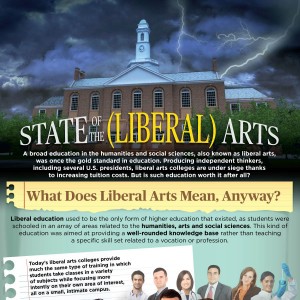State of the (Liberal) Arts
A broad education in the humanities and social sciences, also known as liberal arts, was once the gold standard in education. Producing independent thinkers, including several U.S. presidents, liberal arts colleges are under siege thanks to increasing tuition costs. But is such education worth it after all?
What Does Liberal Arts Mean, Anyway?
Liberal education used to be the only form of higher education that existed, as students were schooled in an array of areas related to the humanities, arts and social sciences. This kind of education was aimed at providing a well-rounded knowledge base rather than teaching a specific skill set related to a vocation or profession.
Today’s liberal arts colleges provide much the same type of training in which students take classes in a variety of subjects while focusing more intently on their own area of interest, all on a small, intimate campus.
Liberal arts education focuses not on the practice of a profession but broader skills like:
- Problem-solving
- Logic
- Ethics and social responsibility
- Analytical reasoning
- Oral and written communication
Sharp Decline
While a broad liberal arts curriculum was the standard in higher education for much of the history of the U.S., schools that focus exclusively on such education are falling out of favor. Where do things stand now?
212
Liberal arts colleges identified by 1990 study (1)
130
Colleges that met the criteria when the study was revisited in 2012 (1)
39%
Decline (1)
17 million
Total undergraduates in U.S. (1)
300,000
Estimate of students at liberal arts colleges (1)
Why Have Things Changed?
Money, money, money. College is expensive; families can’t afford to waste a nickel.
Average tuition, room and board by year (2)
1976-77: $2,275
1981-82: $3,489
1986-87: $5,206
1991-92: $7,077
1996-97: $9,206
2001-02: $11,380
2006-07: $15,483
2011-12: $19,339
Since 1976, college tuition has risen more than 750%.
That’s more than double the rate of inflation in the same time. (3)
With unemployment for recent grads at about 8.5%, many students fear they won’t be able to find a good job if their degree didn’t focus on a specific skill set. After all, if they’re shelling out nearly $80,000 for a four-year degree, they’d better have something to show for it. (2, 4)
Here’s What You Can Show for It
True, attending a small liberal arts college will probably mean you won’t be qualified to run an IT department, but it’s far from worthless.
Workers who major in humanities or social sciences earn about $2,000 per year more (at age 56-60) than those who majored in professional or pre-professional fields. (5)
8 in 10
Employers who believe every college student should have a broad knowledge base in liberal arts and sciences, regardless of major (6)
74%
Employers who believe liberal arts education is the best preparation for success in the global economy (6)
93% of employers say the ability to think critically, communicate effectively and solve complicated problems is more important than a candidate’s undergraduate major. (5)
Sources:
1. http://bigstory.ap.org
2. http://nces.ed.gov
3. http://inflationdata.com
4. http://www.slate.com
5. http://www.aacu.org
6. http://www.huffingtonpost.com
 Follow
Follow

